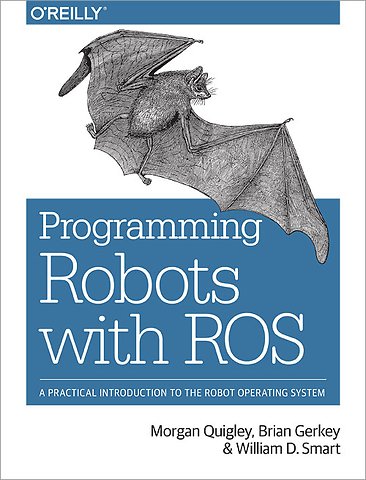

Morgan Quigley is a cofounder of the Open Source Robotics Foundation (OSRF), which develops and maintains the Robot Operating System (ROS).
Meer over de auteursProgramming Robots with ROS
A Practical Introduction to the Robot Operating System
Samenvatting
Want to develop novel robot applications, but don’t know how to write a mapping or object-recognition system? You’re not alone, but you’re certainly not without help. By combining real-world examples with valuable knowledge from the Robot Operating System (ROS) community, this practical book provides a set of motivating recipes for solving specific robotics use cases.
Ideal for enthusiasts, from students in robotics clubs to professional robotics scientists and engineers, each recipe describes a complete solution using ROS open source libraries and tools. You’ll learn how to complete tasks described in the recipes, as well as how to configure and recombine components for other tasks. If you’re familiar with Python, you’re ready to go.
- Learn fundamentals, including key ROS concepts, tools, and patterns
- Program robots that perform an increasingly complex set of behaviors, using the powerful packages in ROS
- See how to easily add perception and navigation abilities to your robots
- Integrate your own sensors, actuators, software libraries, and even a whole robot into the ROS ecosystem
- Learn tips and tricks for using ROS tools and community resources, debugging robot behavior, and using C++ in ROS
Specificaties
Over Brian Gerkey
Over William Smart
Inhoudsopgave
Part 1: Fundamentals
1. Introduction
-Brief History
-Philosophy
-Installation
-Summary
2. Preliminaries
-The ROS Graph
-roscore
-catkin, Workspaces, and ROS Packages
-rosrun
-Names, Namespaces, and Remapping
-roslaunch
-The Tab Key
-tf: Coordinate Transforms
-Summary
3. Topics
-Publishing to a Topic
-Subscribing to a Topic
-Latched Topics
-Defining Your Own Message Types
-Mixing Publishers and Subscribers
-Summary
4. Services
-Defining a Service
-Implementing a Service
-Using a Service
-Summary
5. Actions
-Defining an Action
-Implementing a Basic Action Server
-Using an Action
-Implementing a More Sophisticated Action Server
-Using the More Sophisticated Action
-Summary
6. Robots and Simulators
-Subsystems
-Complete Robots
-Simulators
-Summary
7. Wander-bot
-Creating a Package
-Reading Sensor Data
-Sensing and Actuation: Wander-bot!
-Summary
Part 2: Moving Around Using ROS
8. Teleop-bot
-Development Pattern
-Keyboard Driver
-Motion Generator
-Parameter Server
-Velocity Ramps
-Let’s Drive!
-rviz
-Summary
9. Building Maps of the World
-Maps in ROS
-Recording Data with rosbag
-Building Maps
-Starting a Map Server and Looking at a Map
-Summary
10. Navigating About the World
-Localizing the Robot in a Map
-Using the ROS Navigation Stack
-Navigating in Code
-Summary
11. Chess-bot
-Joints, Links, and Kinematic Chains
-The Key to Success
-Installing and Running a Simulated R2
-Moving R2 from the Command Line
-Moving R2 Around a Chessboard
-Operating the Hand
-Modeling a Chessboard
-Playing Back a Famous Chess Game
-Summary
Part 3: Perception and Behavior
12. Follow-bot
-Acquiring Images
-Detecting the Line
-Following the Line
-Summary
13. On Patrol
-Simple Patrolling
-State Machines
-Defining State Machines with smach
-Patrolling with State Machines
-Summary
14. Stockroom-bot
-Stockroom Simulation
-Driving to Bins
-Picking Up the Item
-Summary
Part 4: Bringing Your Own Stuff into ROS
15. Your Own Sensors and Actuators
-Adding Your Own Sensors
-Adding Your Own Actuators
-Summary
16. Your Own Mobile Robot
-TortoiseBot
-ROS Message Interface
-Hardware Driver
-Modeling the Robot: URDF
-Simulation in Gazebo
-Summary
17. Your Own Mobile Robot: Part 2
-Verifying Transforms
-Adding a Laser Sensor
-Configuring the Navigation Stack
-Using rviz to Localize and Command a Navigating Robot
-Summary
18. Your Own Robot Arm
-CougarBot
-ROS Message Interface
-Hardware Driver
-Modeling the Robot: URDF
-Simulation in Gazebo
-Verifying Transforms
-Configuring MoveIt
-Using rviz to Send Goals
-Summary
19. Adding a Software Library
-Make Your Robot Talk: pyttsx
-Summary
Part 5: Tips and Tricks
20. Tools
-The Master and Friends: roscore
-Parameters: rosparam
-Navigating the Filesystem: roscd
-Starting a Node: rosrun
-Starting Many Nodes: roslaunch
-Testing a Many-Node System: rostest
-Introspection: rosnode, rostopic, rosmsg, rosservice, and rossrv
-Summary
21. Debugging Robot Behavior
-Log Messages: /rosout and rqt_console
-Nodes, Topics, and Connections: rqt_graph and rosnode
-Sensor Fusion: rviz
-Plotting Data: rqt_plot
-Data Logging and Analysis: rosbag and rqt_bag
-Summary
22. The ROS Community: Online Resources
-Etiquette
-The ROS Wiki
-ROS Answers
-Trackers (Bugs and Feature Requests)
-Mailing Lists and Special Interest Groups
-Finding and Sharing Code
-Summary
23. Using C++ in ROS
-When Should You Use C (or Some Other Language)?
-Building C++ with catkin
-Translating from Python to C++ (and Back Again)
-Summary
Index
Anderen die dit boek kochten, kochten ook
Rubrieken
- cadeauboeken
- computer en informatica
- economie
- filosofie
- flora en fauna
- geneeskunde
- geschiedenis
- gezondheid
- jeugd
- juridisch
- koken en eten
- kunst en cultuur
- literatuur en romans
- mens en maatschappij
- naslagwerken
- non-fictie informatief/professioneel
- paramedisch
- psychologie
- reizen
- religie
- schoolboeken
- spiritualiteit
- sport, hobby, lifestyle
- thrillers en spanning
- wetenschap en techniek
- woordenboeken en taal





